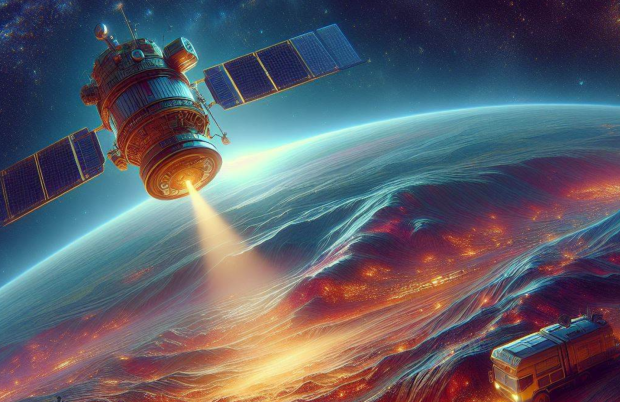Science, Space, Health & Robotics News - Page 2
NASA unveils what the solar eclipse would look like if you were in space
Millions of Americans looked skyward on April 8, 2024, when the Moon passed between the Sun and the Earth, creating an extremely rare phenomenon that only happens a few times in a lifetime.
But what if you were instantly teleported from seeing the total solar eclipse in North America to space? The spectacle wouldn't have been that impressive if you had looked at Earth, and if you had looked at Earth, you would have seen a large ominous shadow slowly moving eastward across the planet. NASA was able to capture this point of view of Earth from the Earth Polychromatic Imaging Camera (EPIC), which is located on the Deep Space Climate Observatory (DSCOVR) satellite.
The satellite is located 1 million miles away from Earth and captured views of Earth being doused in a lunar shadow between 16:02 and 20:32 Universal Time (12:02 and 4:32 p.m. Eastern Time). As you would probably agree, the view of the solar eclipse is much better from Earth's surface, which grants viewers located in the path of totality a rare view of the Sun's active outer atmosphere, or corona. According to Michael Kirk, a NASA research scientist in the Heliophysics Division at NASA's Goddard Space Flight Center, "This view of the corona will never happen again, ever."
NASA confirms the solar eclipse may have damaged your phone camera
The solar eclipse of April 8, 2024 was a total solar eclipse, meaning the Moon passed between Earth and the Sun, obscuring our vision of our local star.
Millions of Americans across North America experienced day briefly turn into night when the Moon passed between Earth and the Sun, creating a dramatic effect that thousands, potentially millions of people captured with their smartphones. Looking at the Sun during any period of time can cause eye damage, which is why scientists recommended people interested in observing the Sun during the eclipse to pick up a pair of eclipse glasses that are designed to filter out the dangerous light rays.
But what about your smartphone camera? Camera sensors, much like human eyes, can easily be damaged by the Sun, which is why many photographers that want to capture images of the Sun and don't want to damage any expensive gear decide to purchase a solar filter, which serves the same purpose as solar eclipse glasses for humans.
Continue reading: NASA confirms the solar eclipse may have damaged your phone camera (full post)
Scientists announce a once-in-a-lifetime event that will light up the night sky
Amateur astronomers around the world are preparing to view an astronomical event that only occurs once every 80 years, and it's expected to happen between now and September this year.
The event can be traced back to a binary star system within the constellation Corona Borealis, also known as the "Northern Crown." This star system is too dim to see with the naked eye, but after taking a closer look with space-observing instruments, astronomers find two stars: one massive red giant and a smaller white dwarf. Both of these stars are locked in a gravitational tug of war and represent different stages in a star's life. The red giant is a star that has burnt through all its hydrogen, expanding it massively and is actually what's expected to happen to our own Sun.
The other is a white dwarf, which is much further down the road in the death of a star as all of its atmosphere has been completely blown away, leaving behind an incredibly dense core. The once-in-a-lifetime event is a result of the interaction between these two stars, as matter ejected from the red giant gets gobbled up by the white dwarf, slowly building around its surface. Reports indicate that once the white dwarf has accumulated approximately the same amount of matter as the Earth, it creates a thermonuclear reaction.
First time since 1803 trillions of bugs will invade 16 states in the US
America's heartland and some surrounding states will be subject to a massive invasion by trillions of singing bugs in an event that hasn't taken place for at least 200 years.
According to reports, trillions of cicadas will be surfacing from the ground at the same time this year as two groups known as Brood XIX, or the "Great Southern Brood," and Brood XIII, known as the "Northern Illinois Brood". For at least 200 years these groups of cicadas emerged at different times, but this year they will emerge simultaneously creating swarms of trillions of flying signing bugs. Notably, there isn't an extensive overlap between the two groups, but some regions in the center of the US will be battling against more than double the number of cicadas.
David Althoff, a professor at Syracuse University's Department of Biology, told ABC News that residents used to the annual occurrence of cicadas will need to prepare for this year's emergence as it will be a "far cry from the annual occurrences". Furthermore, Brood XIX, the largest geographic extent of all periodical broods, only surfaces once every 13 years, while Brood XIII emerges every 17 years. The last time these two broods emerged from the ground at the same time was in 1803, and the next time they will emerge at the same time won't be until 221 years have passed.
SpaceX puts a next-gen satellite into Earth's orbit that will discover critical minerals
SpaceX recently announced the successful deployment of its Bandwagon-1 mission, which was launched from Launch Complex 39A at Kennedy Space Center in Florida.
The rideshare mission totaled eleven spacecraft from multiple companies around the world, with the Falcon 9 rocket deploying: KOREA's 425Sat, HawkEye 360's Clusters 8 & 9, Fleet Space Technologies' Centauri-6, iQPS's QPS-SAR-7 TSUKUYOMI-II, Capella Space's Capella-14, and Tata Advanced Systems Limited's TSAT-1A. More specifically, Fleet Space Technologies, the team behind the world's smallest voice-enabled satellite, Centauri-4, issued a press release about the achievement the company has made with the successful deployment of Centauri-6.
According to the South Australian company, which was named Australia's fastest growing company by the Australian Financial Review, Centauri-6 will add to Fleet Space's ever-growing presence in low-Earth orbit that's designed to provide solutions to critical mineral discoveries on Earth's surface without damaging the environment.
SpaceX plans to leave the first humans on Mars stranded with no way home
SpaceX has conducted a presentation at its Starbase facility in Boca Chica, Texas, revealing some key details about its upcoming Mars missions that will feature the world's most powerful rocket, Starship.
The company's CEO, Elon Musk, has taken to stage to discuss what fans of SpaceX can expect out of the company in 2024 and what will be involved in creating a sustainable presence on the surface of Mars. Musk said that this is the first time in human civilization that Earth is capable of making the species multiplanetary, and all of this hinges of the success of Starship, the world's largest and most powerful rocket ever created.
Musk outlines that mass to orbit is a key factor in achieving a Mars base, and when Starship is complete, it will be capable of taking 200 tons to orbit while being fully reusable. The SpaceX CEO explains that once Starship is in orbit, it will need to be refueled by a tanker that's also in orbit. This new technology will be called Ship to Ship Propellent Transfer, and for every trip to Mars, Starship will need to be refueled six times, so a ratio of 5 to 1. Musk said that SpaceX plans on demonstrating Ship to Ship Propellent Transfer sometime next year.
Elon Musk reveals when SpaceX will launch Starship again
SpaceX has issued a major update for what fans of the space fairing company can expect throughout 2024, and one of those updates is when Starship, the world's largest and most powerful rocket, will take to the skies once again.
The update was hosted by SpaceX CEO Elon Musk, who took to the stage at Starbase for a 45 minute presentation outlining all of what SpaceX is working on and what we can expect out of 2024. If you haven't been keeping up with Starship news, the world's largest rocket conducted its third orbital test flight last month and it was a major success, with the massive rocket successfully reaching orbit.
Now SpaceX is preparing for the fourth test flight and according to Musk the main objectives will be landing the rocket somewhere in the ocean on a virtual tower. Notably, SpaceX plans on "catching" Starship's booster Super Heavy on a tower SpaceX call Mechazilla.
Continue reading: Elon Musk reveals when SpaceX will launch Starship again (full post)
Scientists peer into the heart of an explosive galaxy in unprecedented detail
The world's most powerful space telescope, the James Webb Space Telescope, has pointed its extremely sensitive infrared instruments at the heart of a galaxy that's teeming with newly born stars.
NASA's Webb telescope captured the Cigar Galaxy, scientifically known as Messier 87 (M87), to capture the region of space in gorgeous high detail. M87 is located 12 million light years away from Earth within the constellation Ursa Major, and according to NASA this region of space is forming stars 10 times faster than our own galaxy the Milky Way. M87 was captured with Webb's infrared instruments, giving researchers a new look into the heart of the region of space that other telescopes typically can't see due to it being obscured by dust and gas.
Infrared light is able to penetrate the dust and gas, making Webb an incredible telescope to see further in space than ever before. The different colors seen in the above image represent different aspects of the galaxy. For example the dark, reddish-brown colors represent dust, while the green specks indicate the presence of iron leftover from supernovas, or stars that run out of fuel and end their in a violent explosion.
Scientists discover one side of the US sees more UFOs than the other
A team of researchers analysed a dataset that contained 98,000 reports collected over 20 years and found that environmental roles play a factor in the number of UFO, or Unidentified Aerial Phenomena (UAP) sightings.
The new study published in the journal Science Reports examined a dataset collected over 20 years by the National UFO Research Center. The goal of the study was to see how environmental variables such as light pollution, cloud cover, airports, and military bases coincide with UFO reports. The findings indicate you are more likely to see a UFO if you live in the western US, a finding that was "completely unexpected," according to the study's lead author.
So, why do the Western states see more UFOs? According to the team behind the study there are a few reasons why, such as the wide-open spaces and year-round weather that leads people to be more outdoors than other states, resulting in more sightings as people are "looking skyward," according to Medina.
Continue reading: Scientists discover one side of the US sees more UFOs than the other (full post)
US government tasks NASA with creating an out-of-this-world clock
The White House has tasked NASA and other agencies to come up with an idea to keep track of time on Earth, but not on Earth.
The White House has officially instructed NASA and other US agencies to work with the appropriate international agencies to develop a preliminary idea by the end of the year that creates a moon-centric time reference system, or a moon clock. Notably, there is less gravity on the moon due to its lower mass, which means time moves slightly differently than here on Earth, precisely 58.7 microseconds quicker every day. Why do we need a moon clock?
Highly sophisticated computer systems rely on timing to make communications possible, and with NASA's push back into space exploration with its Artemis missions and future plans, along with other countries' space agencies, keeping track of the time has become more paramount than before. NASA has already proposed creating an atomic clock for the moon, an extremely precise clock that would create a unified time for the moon. Furthermore, the moon will not have a daylight saving time, according to Kevin Coggins, NASA's top communications and navigation official.
Continue reading: US government tasks NASA with creating an out-of-this-world clock (full post)











